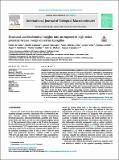Por favor, use este identificador para citar o enlazar a este item:
http://hdl.handle.net/10261/190477COMPARTIR / EXPORTAR:
 SHARE SHARE
 CORE
BASE CORE
BASE
|
|
| Visualizar otros formatos: MARC | Dublin Core | RDF | ORE | MODS | METS | DIDL | DATACITE | |

| Título: | Structural and biochemical insights into an engineered high-redox potential laccase overproduced in Aspergillus |
Autor: | Salas, Felipe de CSIC ORCID ; Cañadas, Rubén; Santiago, Gerard; Virseda-Jerez, Alicia; Vind, Jesper; Gentili, P.; Martínez, Ángel T. CSIC ORCID ; Guallar, Victor; Muñoz, Inés G.; Camarero, Susana CSIC ORCID | Palabras clave: | Fungal laccase Aspergillus oryzae Crystal structures SAXS Kinetics Circular dichroism |
Fecha de publicación: | 7-sep-2019 | Editor: | Elsevier | Citación: | International Journal of Biological Macromolecules 141: 855-867 (2019) | Resumen: | Fungal laccases have great potential as biocatalysts oxidizing a variety of aromatic compounds using oxygen as co-substrate. Here, the crystal structure of 7D5 laccase (PDB 6H5Y), developed in Saccharomyces cerevisiae and overproduced in Aspergillus oryzae, is compared with that of the wild type produced by basidiomycete PM1 (Coriolopsis sp.), PDB 5ANH. SAXS showed both enzymes form monomers in solution, 7D5 laccase with a more oblate geometric structure due to heavier and more heterogeneous glycosylation. The enzyme presents superior catalytic constants towards all tested substrates, with no significant change in optimal pH or redox potential. It shows noticeable high catalytic efficiency with ABTS and dimethyl-4-phenylenediamine, 7 and 32 times better than the wild type, respectively. Computational simulations demonstrated a more favorable binding and electron transfer from the substrate to the T1 copper due to the introduced mutations. PM1 laccase is exceptionally stable to thermal inactivation (t1/2 70 °C = 1.2 h). Yet, both enzymes display outstanding structural robustness at high temperature. They keep folded during 2 h at 100 °C though, thereafter, 7D5 laccase unfolds faster. Rigidification of certain loops due to the mutations added on the protein surface would diminish the capability to absorb temperature fluctuations leading to earlier protein unfolding. | Descripción: | 13 p.-7 fig.-2 tab | Versión del editor: | https://doi.org/10.1016/j.ijbiomac.2019.09.052 | URI: | http://hdl.handle.net/10261/190477 | DOI: | 10.1016/j.ijbiomac.2019.09.052 | ISSN: | 0141-8130 | E-ISSN: | 1879-0003 |
| Aparece en las colecciones: | (CIB) Artículos |
Ficheros en este ítem:
| Fichero | Descripción | Tamaño | Formato | |
|---|---|---|---|---|
| Int J Biological Micromolecules_de Salas_2019.pdf | 3,38 MB | Adobe PDF |  Visualizar/Abrir |
CORE Recommender
SCOPUSTM
Citations
18
checked on 18-abr-2024
WEB OF SCIENCETM
Citations
14
checked on 22-feb-2024
Page view(s)
315
checked on 19-abr-2024
Download(s)
64
checked on 19-abr-2024
Google ScholarTM
Check
Altmetric
Altmetric
NOTA: Los ítems de Digital.CSIC están protegidos por copyright, con todos los derechos reservados, a menos que se indique lo contrario.
